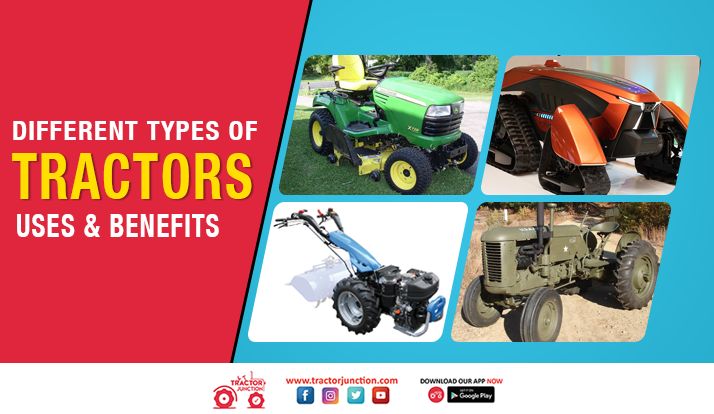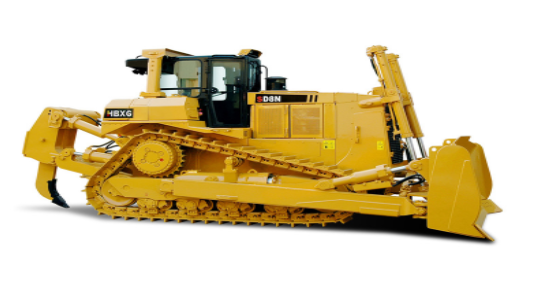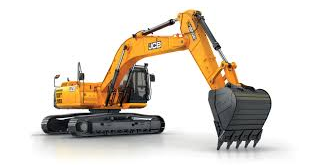
In ancient times, The man started using ox and cows for farming. Later machinery and more advanced types of machinery took their place, and the tractor is one of them. The tractor is an integral farming machine that mechanizes farming tasks like planting, tillage, plowing, etc. In this article know about Different Types of Tractors – Application, Uses & Benefits.
What is Tractor and Use of Tractors in Modern Farming

A tractor is a vehicle specially manufactured to deliver high torque at a lower speed. It hauls a trailer or machinery used in agriculture, construction, and industrial. The tractor is the combination of two words, “traction and motor.” A tractor is used to pull heavy loads for different farming tasks.
There are many agriculture operations performed by farmers, and for each task, the necessary farming machinery and implements are developed. Similarly, according to the farmer’s needs and demand, there are many types of tractors developed.
Constant innovation and improvement in tractors have made farming more efficient and profitable. Additionally, the Power Take-Off (PTO) function on tractors operates stationary or drawn machinery and implements, similarly enhancing their use. Let us have a look at some of the uses of tractors for farmers:
1. Tilling: Tractors equipped with tillers break up the soil into small clumps, developing a super seedbed by means of eliminating rocks and smoothing the ground for planting.
2. Harvesting: Tractors with harvesting attachments, together with integrated harvesters, cut, thresh, and easy plants, making the harvesting technique more green.
3. Sowing: Tractors with sowing attachments plant seeds efficaciously into the organised soil, either in rows or broadcast throughout the field.
4. Harrowing: Tractors with harrows break up soil clods and create excellent ground, smoothing the soil and eliminating particles to put together the land for planting.
5. Sowing: Tractors with sowing attachments plant seeds efficaciously into the organised soil, either in rows or broadcast throughout the field.
6. Landscaping: Tractors with bulldozer blades or backhoes stage land, dig trenches, and cast off timber, making ready the land for cultivation.
7. Ploughing: Tractors with ploughing attachments turn over the soil, disposing of unwanted flowers and weeds to prepare an easy, fertile land for sowing.
8. Hauling: Tractors with trailers transport heavy loads, such as crops, fertilizers, and implements, facilitating the movement of machines and other stuff throughout the farm.
Modern tractors are critical for Indian farmers. Their versatility revolutionises farming. They perform ploughing, tilling, harrowing, sowing, harvesting, hauling, and landscaping tasks.
Different Types of Tractors
Below, we give details about different types of tractors – application, uses & benefits
1. Utility Tractors

Firstly we discuss utility tractors. This type of tractor is used for farming operations such as plowing and pulling heavy implements. If farmers can not afford to buy additional machines to perform tasks, utility tractors are good. These tractors range from 45 Hp to 140 Hp and multifunctional tractors used for farming. Tractors come with the low to medium type engines and pull the heavy implements.
These tractors easily add other equipment like harvesters, tillers, hay cutters, Threshers, and many more. These generally have gasoline or diesel engines.
2. Compact Tractors

Next, compact tractors are used in vineyards, fruit yards, and nut yards. They are constructed in a way that the user can sit comfortably and choose the hanging fruits or trim the trees at the same time. The best advantage of compact tractors is they can be adjusted in every space of the yard. Compact tractors come at a smaller size, and it consumes less fuel that saves money. Moreover, compact tractor uses for productive farming.
3. Row Crop Tractors

Row crop tractors used in farms wherein farmers plant crops in a row. These tractors are all around tractors that perform various farming tasks you need to do, Including weed control, leveling, plowing, harrowing, and pulling seed drills. They consist of many benefits like user-friendly, adequate row spacing, comfortable driving, greater ground clearance, ease of steering, easily attached and detached attachments, etc.
4. Industrial Tractors

Industrial tractors, as the name suggests, mainly used in the industry more than agriculture. Formerly, these tractors called tuggers. These tractors mostly used to pull heavy loads and fit the cranes to lifting heavy weights easily. These tractors are different from the agriculture tractor. They do not have a three-point hitch as farming tractors. These tractors have drawbars, and they come in various models with HP’s strengths.
5. Garden Tractors

Garden tractors come in the engine power range of 1 hp to 20 hp, and they have very small construction size. These tractor uses mainly for cutting the grass and making the flower beds in your garden. The wheel of the garden tractor looks like a scooter but much thicker. Until now, more than 100 different types of garden tractors have been made.
6. Implement carrier Tractors

Implement carrier Tractors used to carry and mount different types of implements. Therefore the chassis frame between the front and rear tyres extended. Mounted implements include sprayers, drills, loaders, rotary sweepers, seed drills, and many more. They come in different sizes and designs.
7. Earth Moving Tractors
Earth moving Tractors used in construction, quarries, and dam works. These tractors are extremely heavy and powerful, they come in both tyres and track types. Earth moving tractors are life savers in these places. These tractors use to relocate and move things such as dust, mud, lumber, rocks, debris, etc. There are three types of earth moving tractors, and these include the following.
-
Bulldozer

These machines known as well crawlers, they contain large plates at the front. These plates push rocks, dirt, and they can used to clear out a property located in all types of terrain. They have complete tracks to maintain their balance while doing operations.
-
Excavators

These machines mostly used for digging and demolishing, they can lift heavy pieces of implements and shovel dirt. They consist of a long bucket arm attached to the cab that rotates and their seats elevated. So that drivers can get a view of everything they need to see.

They used for various construction tasks, from digging holes to breaking asphalt. These machines consist of buckets in the back for digging and shovels in the front that can adjusted to your needs.
8. Autonomous Tractors

Autonomous tractors are also called driverless or electric tractors that are controlled or operated by artificial intelligence. These tractors could become the wave of the future for agriculture or industry. They utilize the combination of computers, GPS, drone technology, and satellite. Autonomous Tractors avoid the need of human tractor operators. A single operator controls an unlimited number of tractors from a single location. Some industry experts give suggestions that a more realistic estimate would be around a dozen. Their development excited the farming community for many years, And this enthusiasm is not going to subside soon.
9. Military Tractors

The militaries use military tractors for construction and demolition, temporary road building, and other high projects in high-risk areas. They known as artillery tractors, used primarily in the 1970s for moving guns and heavy military implements. They manufactured to travel varying and difficult types of terrain. The design of Military tractors is the same as civilian industrial tractors. They manufactured with the reinforced tractor frames and undercarriages to withstand landmines and other explosive devices. These tractors sometimes designed with the amphibious or semi-amphibious capabilities. They travel on tracks, wheels, and semi tracks.
10. Two-wheel tractors
 Two-wheel tractors are the lighter weight and smaller tractors used for tilling, plowing, and pulling smaller implements such as harvesters, seeding equipment, and trailers. They called walking, single-axle, or walk-behind tractors. These used in small farms and gardens. The small gasoline engines usually power these tractors, and operators walk behind while using it.
Two-wheel tractors are the lighter weight and smaller tractors used for tilling, plowing, and pulling smaller implements such as harvesters, seeding equipment, and trailers. They called walking, single-axle, or walk-behind tractors. These used in small farms and gardens. The small gasoline engines usually power these tractors, and operators walk behind while using it.
FAQs
Q1. What is the use of tractors in agriculture?
Ans. Tractors in agriculture mechanize tasks like ploughing, planting, and harvesting, enhance efficiency, increase productivity, and support modern techniques like precision farming and GPS guidance.
Q2. Besides traditional ploughing and planting, what other tasks can tractors perform?
Ans. Tractors can perform tasks like fertilizing, harvesting, landscaping, bush clearing, material hauling, lawn care, tilling, spraying, and operating attachments for various farm and maintenance activities.
Q3. What is the use of modern implements in agriculture?
Ans. Modern agricultural implements enhance efficiency, precision, and productivity in farming, aiding in planting, harvesting, tilling, fertilizing, and irrigation, thereby improving resource use and crop yields.
Q4. Which is the best tip for improving farming with modern tractors?
Ans. Embracing precision agriculture is the best way to improve productivity in the field.
Q5. What is the basic agenda for modern agriculture in India?
Ans. The basic agenda for modern agriculture in India includes enhancing productivity through technological innovation, promoting sustainable farming practices, and improving resource use efficiency.
We hope you enjoy and like this blog, now you can get the information regarding different types of tractor use with application, uses & benefits.
For more information, stay tuned with TractorJunction.


